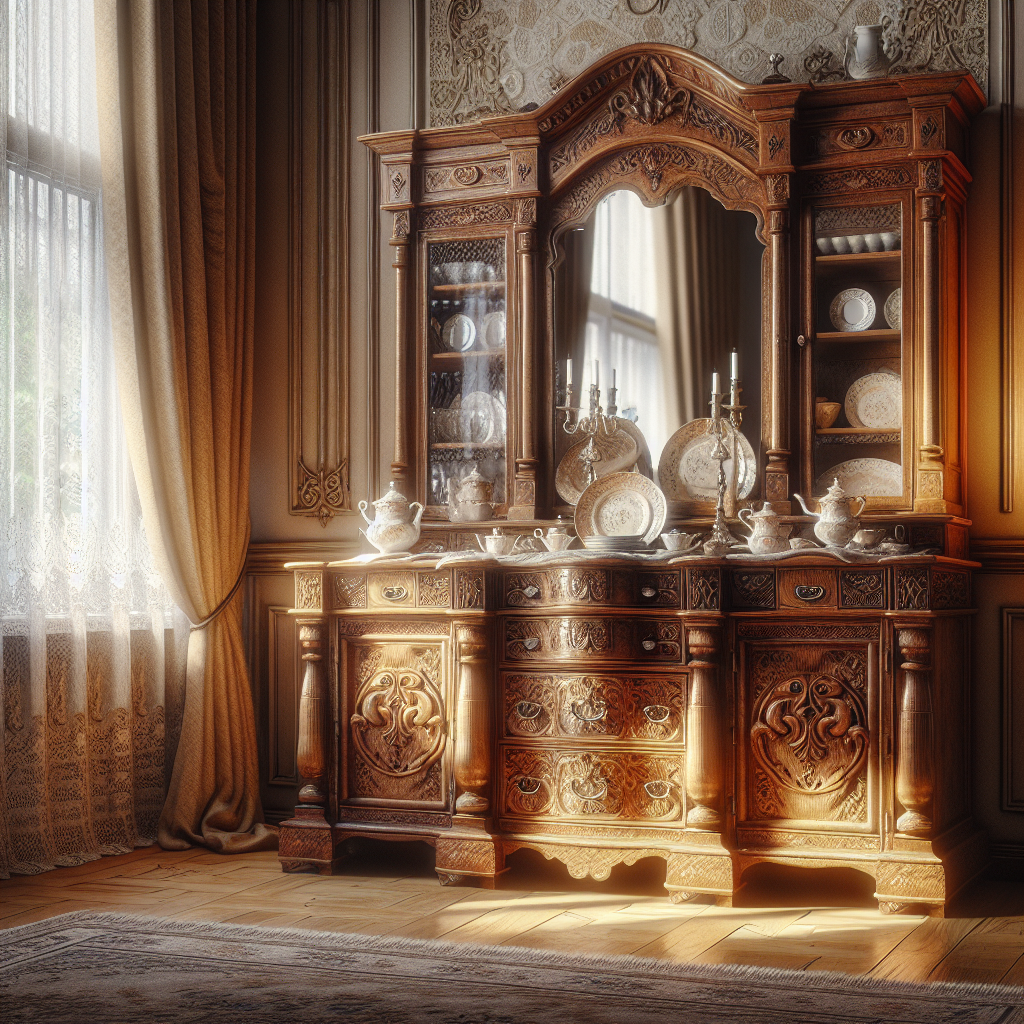The Heart of the Dining Room: History of the Dresser Unit
The Heart of the Dining Room: History of the Dresser Unit


The history of furniture is rich and intertwined with our own human evolution. One such quintessential piece is the dresser unit, an object with a past as fascinating as its function. Originating in the grand halls of the medieval period, it transitioned into a familiar feature in kitchens, dining rooms and parlours by the 17th century. Its historical narrative unfolds with various styles, designs, and functions taking shape through the centuries, ranging from the luxurious high-status display cabinet of yesteryears to our modern-day utility and decor essentials.
Importance of dresser units in dining rooms
In any dining room, one piece of furniture that stands out for its versatility and functionality is the dresser unit. Providing invaluable storage for crockery, cutlery, and other tableware, a dresser unit can easily become the heart of a dining room. Not just practical, it also adds an undeniable aesthetic charm, making it a much sought-after
piece for those keen on tasteful interior design.
The Evolution of the Dresser Unit
Evolving over the centuries, the dresser unit has undergone transformations in style, material and usage. From lavish display showcases in medieval halls, its function shifted towards utilitarian objectives, eventually becoming an integral part of dining rooms as well as kitchens.
Origins of the dresser unit in dining rooms
The antecedent of the modern dresser unit, the dressoir as it was known in medieval times, was a high-status object often placed in grand halls. They were typically adorned with ornate carvings and paintings or draped in stunning textiles. Here, silverware, fine plates, flagons of wine, and food were artfully arranged for display. This showcased not just the wealth and status of the owner but also their taste in fineries.
In France, the dresser was so significant that the number of shelves it had mirrored the owner's social ranking. The more affluent dwellings required steps to reach the topmost levels, signifying the stature of the residents.
In the 17th century, the dresser units began making regular appearances in ''everyday'' homes. Here, they were often constructed from oak, elm, pine, walnut or fruitwood and comprised a base of cupboards or drawers with a separate shelving top. They provided increased functionality in terms of storage while still maintaining a nod to their decorative past.
Development of styles and design
Throughout the 18th to 19th centuries, dresser units became increasingly common; however, the styles evolved to suit the times. In the grand dining rooms of the upper class, dressers made from imported mahogany largely replaced the more humble wood variants.
Yet, the traditional dresser persevered in smaller homes and those below stairs. The designs often echoed the prevalent style sense, albeit simplified by the workmanship of countryside craftsmen. These designs bore the influence of local customs and practices, giving rise to distinct regional variants.
● The dresser units continued to be an essential household fixture right into the 20th century, their forms reflecting a mix of tradition and evolving social preferences.
● Regional variations also emerged – each region had its unique style, characterised by idiosyncratic features that experts could recognise instantly.
Common Types of Dresser Units for Dining Rooms
Today, dresser units come in a myriad of styles and designs, catering to a plethora of interior themes and requirements. Two notable examples include the Welsh dresser and the Pine dresser, both possessing their unique attributes and rich histories.
Welsh dresser
Dating back to the 1600s, the Welsh dresser, also known as the china hutch in the United States, is a classic piece of kitchen furniture. Contrary to the name, these dressers weren't exclusive to Wales but were equally popular in Ireland.
These fixtures were traditionally made from oak, evolving later to include other types of wood. They incorporated a drawer and cupboard-filled sideboard-type bottom topped with open shelving – a layout that optimised functionality while providing room for decoration. Certain regional versions were adapted to local necessities, for instance, the Scottish Highland dresser that featured a tin-lined porridge drawer.
Today, a Welsh dresser is a highly sought-after furnishing, with original pieces fetching huge sums and reproductions offering a more affordable alternative.
Pine dresser
The Pine dresser, as the name suggests, is a piece of furniture made primarily from pine wood. Pine, being lightweight, strong, and relatively affordable, became a popular choice for crafting dressers in a variety of styles - from antique and traditional to modern and contemporary.
Whether a small, compact unit or a spacious dresser with multiple drawers and sections, these pieces offer ample storage for personal items and household belongings. Depending on individual tastes and requirements, they come as naturally finished or painted/stained in different colours.
Useful in multiple room scenarios - in your bedroom for storing clothes, in your dining room for keeping your chinaware, or in your living room for other miscellaneous objects – a pine dresser adds functionality while enhancing the aesthetic appeal of the space it occupies.
The Functionality and Aesthetics of Dresser Units
The contemporary dresser unit brings together functionality and aesthetics seamlessly. Its prime attribute is its abundant storage ability. But equally important is its capacity to lend a decorative aspect to a room – displaying keepsakes, antiques, beautiful crockery, or other ornamental items – elevating it beyond just a storage unit.
Storage and organisation purposes
The modern dresser unit provides a solution to two essential needs – storage and organisation. With their multiple drawers, cupboards, and shelves, they efficiently store a vast range of items, including:
Crockery
Cutlery
Table linens
Decorative items
Books
Photographs
In smaller rooms or apartments where space is at a premium, dressers are saviours, providing essential storage while ensuring that everything remains neatly arranged and easily accessible.
Display and decorative aspects
Beyond its utilitarian advantages, a dresser unit also serves an aesthetic role, becoming a centre stage to showcase your decorative artefacts. The upper shelves offer an ideal platform to display your pretty crockery, prized antique pieces, family photos, or other beloved keepsakes.
In the countryside homes of earlier centuries, the more ornate the dresser, the more likely it was to hold a place of honour in the dining room, flaunting the best china.
Today, this trait continues - a stylishly accessorised dresser not only enhances the room's overall décor but also lends a personal touch, speaking volumes about the inhabitants' tastes and preferences.
Choosing the Right Dresser Unit for Your Dining Room
It's important to select a dresser unit that complements your dining room perfectly. Not a mere purchasing choice, picking the right dresser involves several considerations – size and space availability, preferred material and finish, and its ability to coordinate harmoniously with existing furniture.
Size and space considerations
When choosing a dresser unit, considering the size of the room and available space is paramount. Here are a few pointers to help you decide on the ideal size:
● Measure the Room: Before shopping for a dresser, measure the space where you intend to place it. Ensure you have enough area not just for the dresser but also to open its drawers and doors comfortably.
● Visualise: Canvass in your mind's eye how the dresser will complement other furnishings in the room. It should neither overwhelm the space nor get lost in it.
● Functionality: Consider the amount of storage you require. If you have numerous items to store, you might need a larger unit.
Material and finish options
The material and finish of a dresser unit greatly influence its look and longevity. Woods like oak, pine, and mahogany are popular choices for their strength, durability, and natural beauty. However, each type of wood dictates a different style - while mahogany signals a grandeur reminiscent of the 18th-century dining room, pine offers a cosy country cottage appeal.
The finish, too, affects the appearance and feel of the dresser. Natural wood finishes uphold the rustic or classical charm, whereas painted or stained versions can be tailored to match your room's colour scheme.
Coordinating with existing furniture
To create a cohesive, harmonious look in your dining room, the dresser unit should coordinate seamlessly with the existing furniture. Consider both the style and colour tones in your current setup.
A rustic pine or oak dresser would blend well in a country-style home, whereas a mahogany piece functions brilliantly in an opulent, classical setting. For contemporary homes, sleek, minimalistic designs or those with a pop of colour could work wonders.
Remember, the dresser needs not to replicate other items of furniture but subtly tie in to create a balanced, harmonious, and visually appealing space.
The dresser unit is a timeless piece with a history as rich and varied as its purpose. Its journey has seen it evolve from a status symbol of medieval nobility to a prized possession in modern households. Its versatile nature, myriad styles and designs cater to our unique needs, aesthetic preferences, and spatial requirements.
When you contemplate a piece of furniture that has weathered the test of time, meeting ever-changing needs, tastes, and styles while never losing its charm, the dresser unit stands out. Like a reliable friend, it continues to offer its services and charm, unfailingly proving itself an inseparable part of our homes.
